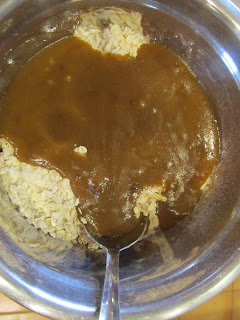 |
| Lentil Stew in bowl, Charoset balls in the middle, flatbread in foreground, figs, dates, cheeses, olives in the background. |
One of our favorite Easter traditions is the Jerusalem dinner. We try to have foods that people would have eaten at the time of Jesus Christ. We put a raised platform (this year it was a long fold up table with the legs still folded under) on the ground and cover it with a cloth. Then I try to keep the smaller grandkids from walking on such an interesting surface (Imagine! a table on the ground! with a tablecloth! Surely it's meant to be walked on!) until we eat dinner. Then we gather most of the pillows in the house and sit on the ground around the table. We eat everything with our hands - the flatbread is to dip the stew. The smallest children get spoons if they want them.
We have lentil stew, flatbread, olives, figs, dates, goat cheese, and grape juice. This year, we added Charoset or Haroset. This is a traditional Passover Seder dish that symbolizes the mortar used by the Jewish slaves to build the storehouses of Egypt.
During this dinner, we talk of how foods were during the Savior's life and some of the traditions we know about from His life. The grandchildren love the thought of sitting on the floor or lying on pillows and eating with their hands. It's interesting because we linger over this dinner, talking, sharing, enjoying the food and the company.
I don't have pictures of the Lentil Soup because Jenny made it at home, but I can vouch that this was one of the best soups I've had. It's not entirely authentic, but it's close. Delicious!
LENTIL QUINOA STEW
1 tbsp. olive oil
1 onion, diced
2 celery stalks, chopped
3 carrots, chopped
3 garlic cloves, minced
2 tbsp. tomato paste
1 tsp. basil, dried
½ - ¾ tsp. sea salt
½ tsp. black pepper
1/8 tsp. crushed red pepper flakes
1 pinch chili powder
1 pinch garam masala
½ tsp. grated ginger root
4 c. vegetable broth
2 c. water
1 c. lentils, sorted and rinsed (use more)
1 can of garbanzo beans
½ c. quinoa, rinsed well
1 can petite dice tomatoes
¼ c. fresh cilantro, chopped
1 tsp. oregano, dried
1 tbsp. apple cider vinegar
Heat oil in a large stockpot over medium heat, and sauté onions until translucent, about 5 minutes. Add the rest of the veggies and spices and stir. Turn heat up to medium-high and add the broth, water, lentils and quinoa. Stir. Cover. Bring to a boil and lower the heat. Simmer for 25 minutes, stirring occasionally. With a blender, puree half of the soup. Finally, add the tomato, cilantro, and apple cider vinegar. Stir and serve.
(You can also cook in crockpot on Low for 8 hours. Just add the quinoa at halfway point, and a little more water/broth. Can assemble all but lentils and quinoa in the crockpot the night before, too.)
6 servings.
The flatbread is another big hit. I try to make at least one per person - this recipe makes 8 generous flat breads but I usually double it. I also realize it is neither authentic nor Kosher for Passover because of the yeast, but it's really good. And it turns out like pita bread with a pocket in the middle.
FLAT BREAD
3 tsp. yeast
1½ cups WARM water
3 tbs. olive oil
1 tsp. salt
3 cups white flour
1 ½ cups whole wheat flour
Dissolve the yeast into the warm water and add oil and salt to that mixture. Mix the flours and knead them into the liquid mixture. Let dough rise for 30 to 40 minutes.
Divide into 8 equal portions (or 16 if you double it). Roll each ball out into a thin, flat, round shape. You can either bake them on a cookie sheet or baking stone at 400 degrees for 10 minutes or so.
We like to grill them: heat your grill, put some foil on the grill, spray with grill spray. Grill each bread on high for 2-3 minutes (until it gets puffy), turn and grill another 2-3 minutes until done. This is the best way.
The Charoset was delicious! It would make a great after-school, after-work, breakfast or whenever snack. Very healthy. You can find dozens of recipes for this, but here's the one I made:
CHAROSET
3 tart apples, peeled, cored and roughly chopped
1 1/4 c. chopped nuts (almonds or walnuts)
Small handful of dried apricots
Small handful of dried figs
Small handful of golden raisins
Small handful of raisins
2 tsp. honey (I think I used a big glob)
1/2 tsp. cinnamon
1/2 tsp. ground cardamom
Juice of one lemon
Put all this in a food processor.
Pulse until roughly chopped. Then process until it's nearly a paste.
Refrigerate. Right before serving, roll into balls - about 1 tablespoon worth.
So have fun with any or all of these recipes and create some traditions of your own!






















































